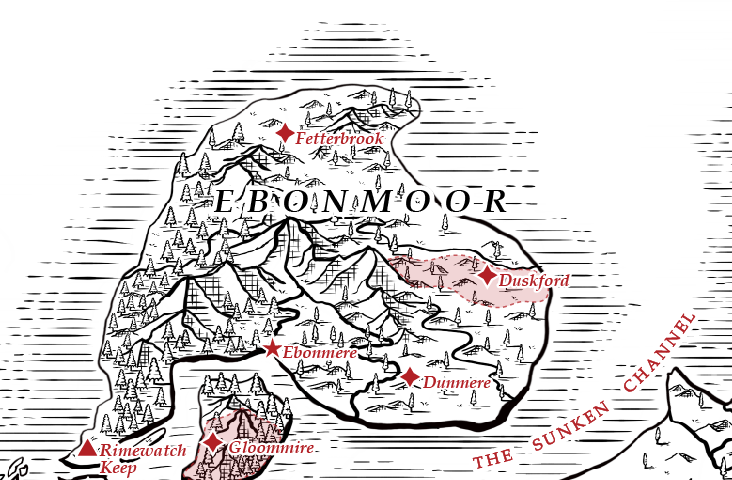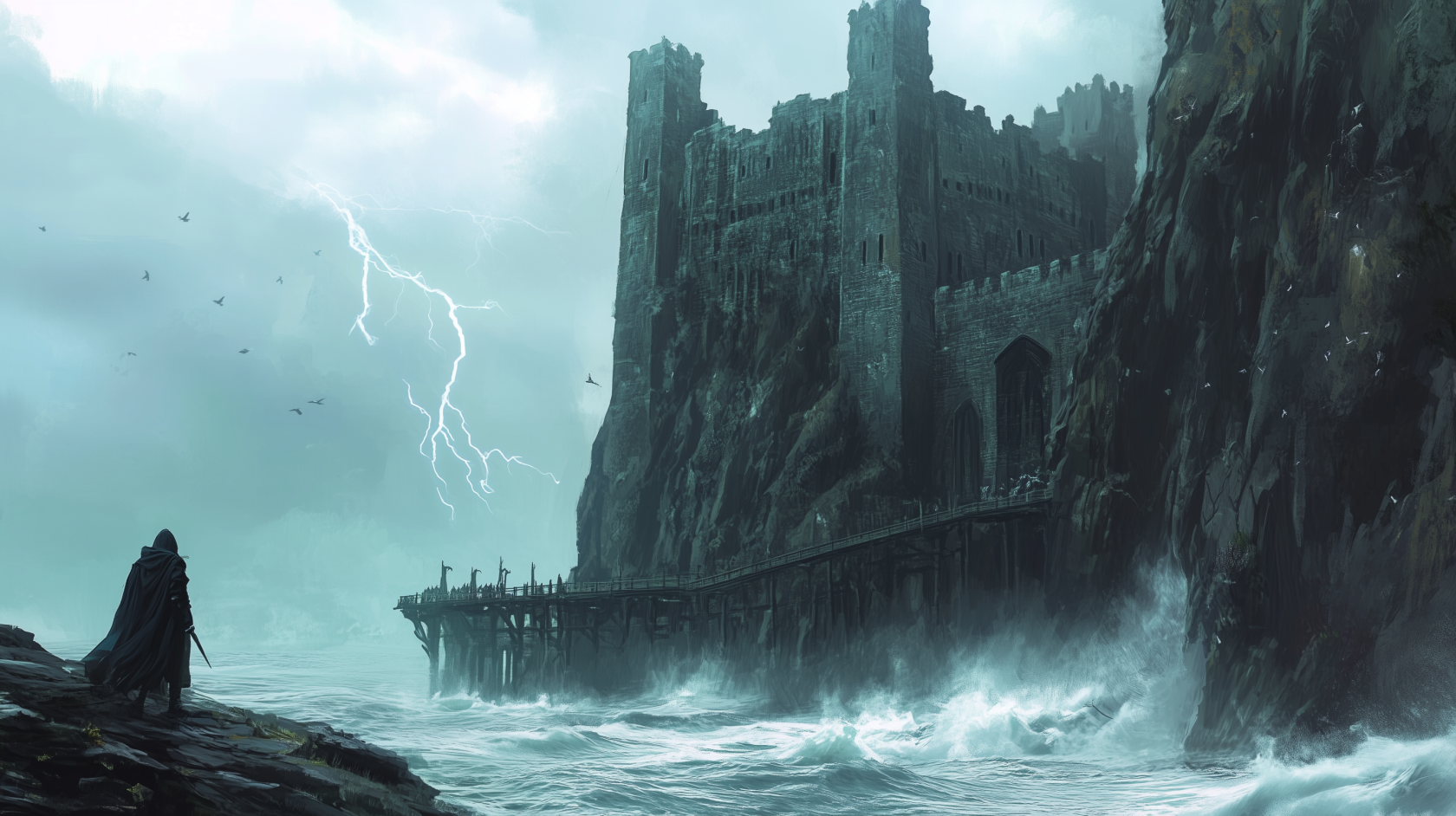Rimewatch Keep
The Sentinel of Ebonmoor
They come with their children in their arms, with nothing but the clothes on their backs, begging—pleading—to be let through. They hold up old documents, coins, relics, anything they think might buy them passage, but none of it matters. Orders are orders. We search them, we check for signs, and if there’s even a whisper of sickness, we send them back. Some cry. Some scream. Some just stand there, staring at us like they’ve already died.
I tell myself I’m keeping Ebonmoor safe. That we’re doing what must be done. But at night, I still hear them. I see their faces when I close my eyes. And I wonder—how many of them were really sick? How many of them could have lived, if we’d only let them through?
– Sergeant Willem Grast, Rimewatch Garrison
Rimewatch Keep has stood for centuries, a relic of a time before Faulmoor’s unification, when the land was a battleground of rival lords, shifting borders, and endless disputes. The fortress was built into the towering cliffs overlooking the treacherous waters of the Greymere Sea, its position chosen for both defensive superiority and control over the land bridge to Ebonmoor. In those early days, Rimewatch was a bulwark against invasion, guarding against both raiders from the sea and the warring factions that sought control of the growing settlements inland.
House Wilthorne and House Valkenmar were once bitter rivals, their domains frequently clashing over land, trade routes, and influence. Rimewatch stood between them, not only as a fortress of war but as a reluctant mediator, ensuring neither side could seize full control of Ebonmoor. Generations of soldiers and commanders upheld their duty to protect the keep, not knowing that one day, it would serve as the last bastion of safety against something far worse than war.
Over time, as the conflicts waned and the two houses grew into allies, Rimewatch Keep slowly transitioned from a fortress of sieges and stalemates to one of security and stability. With peace came opportunity—traders, fishers, and farmers saw value in the land surrounding the keep, knowing that its garrison provided protection from bandits, raiders, and the lawless dangers of the marshes beyond. The coastal waters were rich with fish, and the rocky terrain gave way to fertile patches of farmland, feeding both the keep and the growing settlement around it. Soon, a village emerged beneath the shadow of the keep, with stone homes, small markets, and piers stretching into the sea. Fishing vessels crowded the docks, and merchant wagons lined the roads leading toward the mainland, carrying salted fish, grains, and preserved goods to markets in Vexenford and beyond.
The keep itself remained a military stronghold, but its purpose became more than just war. It was the gateway to Ebonmoor, ensuring that trade, travelers, and diplomacy flowed freely between the island and the mainland. The once-imposing battlements, meant to keep enemies at bay, now welcomed traders, emissaries, and settlers, reinforcing Ebonmoor’s growing importance in Faulmoor’s political landscape.
The fortress and its people thrived in this delicate balance of security and commerce, standing as both a guardian and a bridge between Ebonmoor and Faulmoor. Nobles and merchants alike saw it as a necessary stop—a place of protection, respite, and, in time, prosperity. It was no longer a mere outpost but a vital artery in the lifeblood of Ebonmoor’s future.
The first signs of the Blight were met with skepticism at Rimewatch. Rumors of sickness and strange deaths from the mainland had circulated for weeks, but such tales were common enough in Faulmoor—plague, famine, and war had always come and gone, leaving ruin in their wake but never lasting. The keep’s commanders remained steadfast, unwilling to close off trade or turn away travelers on the basis of fear alone.
But then came the smoke.
Thick, black plumes rose on the horizon from Gloommire, darkening the skies over the sea. At first, many believed it was an accident—a ship aflame in the harbor, perhaps, or one of the construction camps suffering an unfortunate fire. But as the hours passed, the smoke did not fade. It grew, it thickened, and then the reports came: The bridges had been destroyed. The city was burning. The people were dead—or worse.
It was in that moment that Rimewatch truly understood the nature of the threat. This was no ordinary sickness. This was something else. Gloommire had been a city of thousands, a rising trade hub at the heart of a massive construction effort. Its destruction had not been the work of time or war—it had been deliberate, swift, and absolute. No one from Ebonmoor had come to help. No ships had been sent to rescue the stranded. It had been abandoned, quarantined in fire, left to rot beneath the ashes of its own ambition.
The decision was made without debate. Ebonmoor would not share Gloommire’s fate. Rimewatch’s duties shifted overnight—from protecting trade and travelers to ensuring that nothing—absolutely nothing—could bring the Blight into Ebonmoor.
The fortified bridge at Vexenford, once a vital artery between the mainland and the island, became a military lockdown zone, where those seeking passage were subjected to invasive searches and unforgiving scrutiny. Even the slightest cough, the faintest sign of illness—whether it was the Blight or not—could mean exile or execution.
Merchants, once welcomed with open hands, now found themselves at the mercy of the keep’s increasingly unyielding enforcers. The fortified bridge at Vexenford, which had once carried wagons of goods into Ebonmoor, became a bottleneck of desperation. Soldiers stationed at either end no longer saw each other as allies but as gatekeepers protecting their own lands from a shared, unseen enemy. The bridge remained open, but the people crossing it were watched with unrelenting suspicion, and fewer still were allowed through.
On the far end of the bridge, the soldiers of Faulmoor watched their counterparts with growing unease. Once, they had shared meals, laughed over drinks in the village below. Now, they stood apart, their hands gripping their weapons just a little tighter, their gazes wary. The sickness was not just eating away at the bodies of men—it was eroding trust itself.
Beneath the keep, the village that had once thrived grew silent. The fishers who had spent their lives on the docks no longer sailed beyond the sight of the keep’s walls. The farmers who once welcomed traders into their homes now kept to themselves, watching from behind shuttered windows. They were afraid—not just of the Blight, but of the men sworn to protect them, the soldiers who would not hesitate to remove them should they show any sign of illness.
The black smoke over Gloommire had marked the end of an era for Rimewatch. No longer a symbol of peace, it had returned to its roots—a fortress built to stand against an enemy that could not be reasoned with, could not be fought with steel, and could not be allowed to pass.
Though Rimewatch remains untouched by the Blight, it is far from unscathed. The burden of being Ebonmoor’s last line of defense has weighed heavily on those stationed within its walls. The small fishing and farming community that once coexisted with the garrison has grown colder, more insular, fearful of the disease, but also of the men who enforce the quarantine with brutal efficiency. Whispers of resentment have begun to spread, and though no one dares openly defy the keep’s commanders, many wonder how much longer Rimewatch will stand as a protector before it becomes a prison.
The once-great bridge to Ebonmoor, which had symbolized trade and unity, now stands as a wall in all but name, its guards no longer gatekeepers of commerce but enforcers of quarantine. Rimewatch, once the heart of Faulmoor’s greatest peace, has returned to its origins—a fortress of fear, a bastion against an enemy that cannot be fought with steel, and a city now defined not by its thriving people, but by those it refuses to let in.
Detailed Overview
Notable Establishments
The Stone Flask (Tavern & Last Refuge for Travelers)
The only true tavern and inn in Rimewatch, The Stone Flask sits just outside the fortress walls, its heavy stone foundation and thick wooden beams offering a sturdy respite for travelers and soldiers alike. Once, it was a lively meeting place, filled with merchants awaiting passage across the bridge, mercenaries boasting of their latest exploits, and off-duty guards sharing drinks over friendly wagers. Now, it is far quieter. Travelers rarely linger, knowing that even the slightest sign of illness could see them dragged from their rooms in the dead of night.
The innkeeper, Oswin Margrave, an aging former soldier, still runs the place as best he can, though his patience has grown thin. He keeps a careful ledger of all who pass through his doors, knowing that Rimewatch’s commanders expect regular reports. He does not ask too many questions, but he does not abide fools. Those who drink too much, who start fights, or who seem even slightly unwell often find themselves waking up on the wrong side of the keep’s gates, exiled with nothing but the clothes on their back.
The Iron Spire (Armory & Blacksmith Guildhouse)
As Rimewatch Keep remains a military installation, the Iron Spire—a forge and armory built directly into the fortress’s cliffside—has long been responsible for supplying the garrison with weapons, armor, and repairs. Though it was never a merchant’s guild in the traditional sense, the Spire used to take private commissions, crafting fine blades and sturdy tools for merchants and nobles passing through the keep. Since the Blight, its doors are largely closed to all but the soldiers, and any work deemed unnecessary to the keep’s survival has been put on indefinite hold.
Master blacksmith Yorik Draylan, once an ambitious craftsman known for his skill in working silver and steel, now spends most of his time overseeing the reforging of old weapons and maintaining the keep’s dwindling supply of arrows and armor. He has no patience for civilians seeking work done and has been known to turn away desperate farmers looking for tools or repairs, unwilling to waste iron on those who may not live long enough to use it.
The Watcher’s Gate (Garrison Headquarters & Quarantine Checkpoint)
Situated at the entrance to the fortified bridge leading to Vexenford, the Watcher’s Gate is the final checkpoint for anyone seeking passage between Ebonmoor and the mainland. It is a heavily reinforced guardhouse, lined with iron cages, medical examination rooms, and holding cells, where travelers are subjected to invasive inspections before being allowed through.
Here, the true harshness of Rimewatch’s new role is most apparent. Any who cough, tremble, or appear even slightly fevered are immediately detained, often without explanation. Some are turned away, sent back into the unknown. Others are never seen again.
The current commander of the gate, Captain Edric Faulke, is a hard man, unflinching in his duty. He has ordered executions when necessary, ensuring that no risk, no matter how small, makes it across the bridge. While some within Rimewatch consider him a cruel man, few can argue with his results—Ebonmoor still stands free of the Blight, and he intends to keep it that way.


